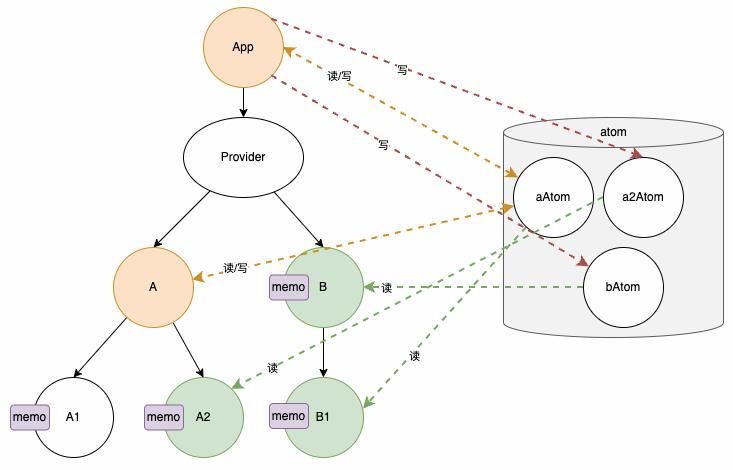React Context 完美替代品 Jotai
Posted 王乐平
tags:
篇首语:本文由小常识网(cha138.com)小编为大家整理,主要介绍了React Context 完美替代品 Jotai相关的知识,希望对你有一定的参考价值。
1. 前言
React 的属性透传场景 虽然有很多方式可以实现,但能做到代码写的少、re-render 轻松处理的方式并不多。
而状态管理工具 Jotai 却可以很好的解决这些问题。

最近的业务和组件场景里 也在用此方式实现。
2. React Context 的不足
常规解决数据透传通常使用 React 的 Context 来实现,但它却有一些不足的地方:
- React Context.Provider 嵌套地狱问题。
- Context value 修改时,触发消费 Context 组件 re-render 的问题(组件引用值未变化时)。
2.1 Provider 嵌套地狱
如下代码所示:
<Context1.Provider value=value1>
<Context2.Provider value=value2>
<Context3.Provider value=value3>
<Context4.Provider value=value4>
<Context5.Provider value=value5>
<Context6.Provider value=value6>
children
</Context6.Provider>
</Context5.Provider>
</Context4.Provider>
</Context3.Provider>
</Context2.Provider>
</Context1.Provider>
2.2 Context re-render
此问题通常有三种方式来解决:
- 将包含多个属性的 Context 剥离成单个 Context 进行使用。但这样会导致 2.1 中嵌套地狱的问题发生。
function Button()
let theme = useContext(ThemeContext);
return <ExpensiveTree className=theme />;
- 将组件剥离成两个,剥离出来的用
React.memo进行包裹,再消费。
function Button()
let appContextValue = useContext(AppContext);
let theme = appContextValue.theme;
return <ThemedButton theme=theme />
const ThemedButton = memo(( theme ) =>
return <ExpensiveTree className=theme />;
);
- 在组件的 return 中,用
React.useMemo包裹,将 Context 中消费的值,做为其依赖项。
function Button()
let appContextValue = useContext(AppContext);
let theme = appContextValue.theme;
return useMemo(() =>
return <ExpensiveTree className=theme />;
, [theme])
但这些方法,都会在使用时增加一些额外的工作量,变得繁琐和易出错。
3. 状态管理库 Jotai 的优势
刚好 Jotai 的其中一部分优势就能解决 React Context 中的这些问题。
Jotai 可以完美的解决嵌套地狱的问题,及精准 re-render 的问题。
简单写了一个例子,来看一下 Jotai re-render:[codesandbox] jotai 配合 React.memo re-render 测试。
例子中 Jotai 的 Atom 及组件消费关系如下:

4. Jotai 核心
Jotai 的学习成本很低,源码也比较易读。核心就三个 API:
- atom:创建原子相关方法。
- useAtom:视图关联原子相关方法。
- Provider:隔离和存储原子实例相关组件。
只需要熟悉这三个 API 的使用就可以轻松上手。
4.1 atom
atom 创建的其实是一份原子描述,并不会进行相关的存储。
可以创建原始原子及派生原子,用法如下:
// primitive atom
function atom<Value>(initialValue: Value): PrimitiveAtom<Value>
// read-only atom
function atom<Value>(read: (get: Getter) => Value | Promise<Value>): Atom<Value>
// writable derived atom
function atom<Value, Update>(
read: (get: Getter) => Value | Promise<Value>,
write: (get: Getter, set: Setter, update: Update) => void | Promise<void>
): WritableAtom<Value, Update>
// write-only derived atom
function atom<Value, Update>(
read: Value,
write: (get: Getter, set: Setter, update: Update) => void | Promise<void>
): WritableAtom<Value, Update>
const primitiveAtom = atom(initialValue)
const derivedAtomWithRead = atom(read)
const derivedAtomWithReadWrite = atom(read, write)
const derivedAtomWithWriteOnly = atom(null, write)
4.2 useAtom
用来将 atom 关联到视图中,形成响应关系。(atom 必须保持引用不变,否则会无限循环)
基本用法:
// primitive or writable derived atom
function useAtom<Value, Update>(
atom: WritableAtom<Value, Update>,
scope?: Scope
): [Value, SetAtom<Update>]
// read-only atom
function useAtom<Value>(atom: Atom<Value>, scope?: Scope): [Value, never]
如果“只读”或“只写”,建议直接使用:
- useAtomValue
- useSetAtom
4.3 Provider
使用上和 React Provider 很相似,当然底层也是用 React Context.Provider 包装的。
主要用来隔离 atom 实例 及存储 atom 实例用的。
有隔离需求可以包裹在视图中,无隔离需求可以不添加,和 React Context.Provider 一样。
基本用法:
const Provider: React.FC<
initialValues?: Iterable<readonly [AnyAtom, unknown]>
scope?: Scope
>
5. Jotai 实现原理
下面看一下内部实现的基本原理。
5.1 Provider
Provider 的创建源码:
const ScopeContainerContext = getScopeContext(scope)
return createElement(
ScopeContainerContext.Provider,
// 创建 atoms 的 weakMap 等存储,挂载在 Provider 中
value: scopeContainerRef.current,
,
children
)
const ScopeContextMap = new Map<Scope | undefined, ScopeContext>()
export const getScopeContext = (scope?: Scope) =>
if (!ScopeContextMap.has(scope))
ScopeContextMap.set(scope, createContext(createScopeContainer()))
return ScopeContextMap.get(scope) as ScopeContext
const scopeContainerRef = useRef<ScopeContainer>()
// 从此处可以看到,Provider 仅作为隔离数据使用,后期不会发生任何 value 层面的变化,
// 所有的触发,都由 内部的 某个 atom 的 listeners 去调用渲染
if (!scopeContainerRef.current)
// lazy initialization
const scopeContainer = createScopeContainer(
// initialValues 仅作用一次,后期的任何变化,将不会有任何效果
initialValues,
unstable_createStore
)
if (unstable_enableVersionedWrite)
let retrying = 0
scopeContainer.w = (write) =>
setVersion((parentVersion) =>
const nextVersion = retrying ? parentVersion : p: parentVersion
write(nextVersion)
return nextVersion
)
scopeContainer.v = version
scopeContainer.r = (fn) =>
++retrying
fn()
--retrying
scopeContainerRef.current = scopeContainer
可以清楚的看到,主要就做了:
- Provider 隔离。
- 在 Provider 的 value 中挂载 atom 实例。
- 通过
scope缓存 createContext 实例。
另外,创建完 Provider 后,未来的所有变化都不会导致其内部的 value 发生变化,所以由 Provider 导致的渲染是不存在的。且 initialValues 也只会消费一次,未来变化也不会响应。
通过
scope的设置,可以实现和原生 React Context.Provider 一样的效果,进行分割及多层嵌套。
5.2 atom
atom 的生成很简单,就是一份描述:
export function atom<Value, Args extends unknown[], Result>(
read: Value | Read<Value, SetAtom<Args, Result>>,
write?: Write<Args, Result>
)
const key = `atom$++keyCount`
const config =
toString: () => key,
as WritableAtom<Value, Args, Result> & init?: Value
if (typeof read === 'function')
config.read = read as Read<Value, SetAtom<Args, Result>>
else
config.init = read
config.read = (get) => get(config)
config.write = ((get: Getter, set: Setter, arg: SetStateAction<Value>) =>
set(
config as unknown as PrimitiveAtom<Value>,
typeof arg === 'function'
? (arg as (prev: Value) => Value)(get(config))
: arg
)) as unknown as Write<Args, Result>
if (write)
config.write = write
return config
生成完成后,会挂载在 Provider 的 store 中。store 由 WeakMap 维护,所以不用担心内存泄漏的问题。
store 中的派生 atom 的触发变化和渲染,主要由 dependencies 和 listeners 实现。
5.3 useAtom
export function useAtomValue<Value>(atom: Atom<Value>, scope?: Scope)
const ScopeContext = getScopeContext(scope)
const scopeContainer = useContext(ScopeContext)
// ...
可以看到 useAtom 中的信息也是通过读取 Context 实现,scope 用来标识与 Provider 匹配。
const [[version, valueFromReducer, atomFromReducer], rerenderIfChanged] =
useReducer<
Reducer<
readonly [VersionObject | undefined, Awaited<Value>, Atom<Value>],
VersionObject | undefined
>,
VersionObject | undefined
>(
(prev, nextVersion) =>
const nextValue = getAtomValue(nextVersion)
if (Object.is(prev[1], nextValue) && prev[2] === atom)
return prev // bail out
return [nextVersion, nextValue, atom]
,
versionFromProvider,
(initialVersion) =>
const initialValue = getAtomValue(initialVersion)
return [initialVersion, initialValue, atom]
)
基于useAtom 创建的值,由 useReducer 实现,可以有效优化部分 re-render 的问题。
useEffect(() =>
const v: versionFromProvider = scopeContainer
if (versionFromProvider)
store[COMMIT_ATOM](atom, versionFromProvider)
// Call `rerenderIfChanged` whenever this atom is invalidated. Note
// that derived atoms may not be recomputed yet.
const unsubscribe = store[SUBSCRIBE_ATOM](
atom,
rerenderIfChanged,
versionFromProvider
)
rerenderIfChanged(versionFromProvider)
return unsubscribe
, [store, atom, scopeContainer])
const subscribeAtom = (
atom: AnyAtom,
callback: (version?: VersionObject) => void,
version?: VersionObject
) =>
const mounted = addAtom(version, atom)
const listeners = mounted.l
listeners.add(callback)
return () =>
listeners.delete(callback)
// TODO should version be `undefined` for delAtom?
delAtom(version, atom)
useRender 的 dispatch 会添加到 atom 的订阅列表中,当 atom 发生变化时,会执行订阅列表中的 dispatch 实现响应。

6. 开发中的注意
如果 Jotai 使用在应用级的全局状态中,不太需要注意。但在开发的组件中使用 Jotai 还是需要注意的。
6.1 开发组件的注意
最根本的一点就是 atom 的隔离问题,不然组件内的数据用的是同一份,会导致干扰。
所以需要额外包裹 Provider 进行隔离:
const ComponentA = () =>
return <div>A</div>;
;
export default () =>
return (
<Provider>
<ComponentA />
</Provider>
);
;
如果原组件有 memo,需要把它移到 Provider 这一层:
export default memo(() =>
return (
<Provider>
<ComponentA />
</Provider>
);
);
如果有 forwardRef 之类的,基本要写两遍:
const ComponentA = forwardRef(( onChange, defaultValue , ref) =>
useImperativeHandle(ref, () => ( changeStyle ));
return <div>A</div>;
);
export default memo(
forwardRef((props, ref) =>
useImperativeHandle(ref, () => (
changeStyle: _ref.current.changeStyle,
));
const _ref = useRef();
return (
<Provider>
<ComponentA ref=_ref />
</Provider>
);
)
);
以上是关于React Context 完美替代品 Jotai的主要内容,如果未能解决你的问题,请参考以下文章